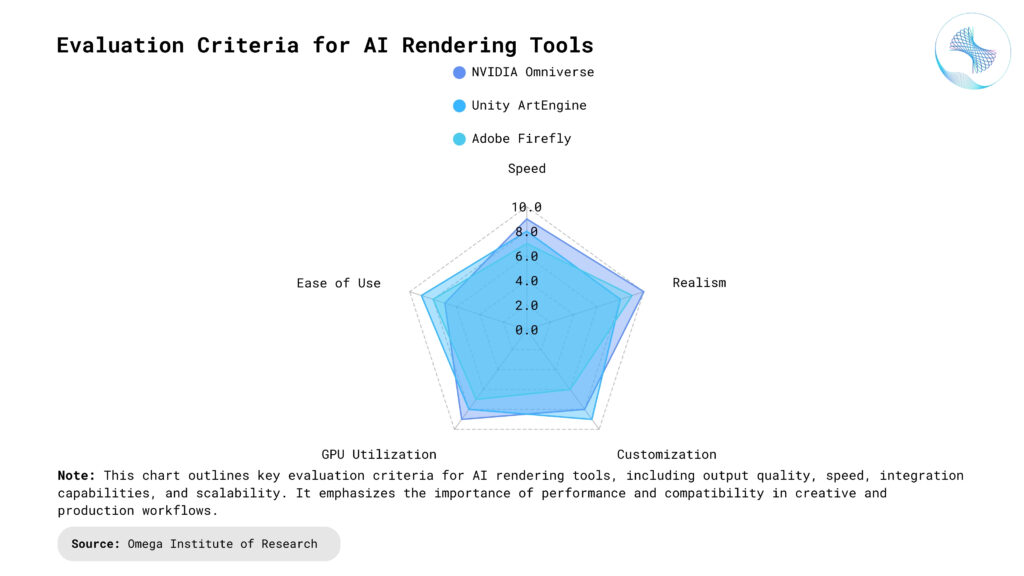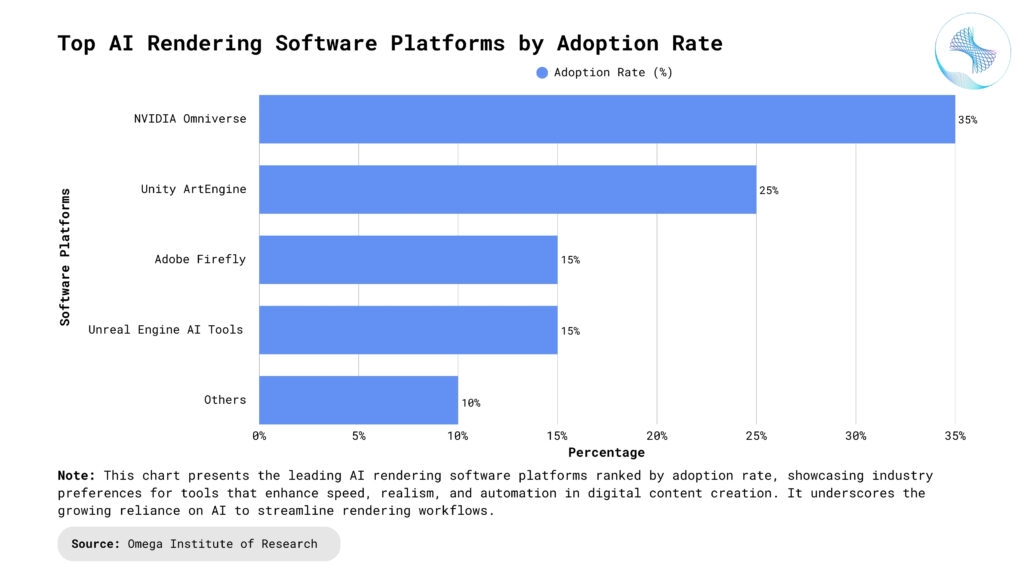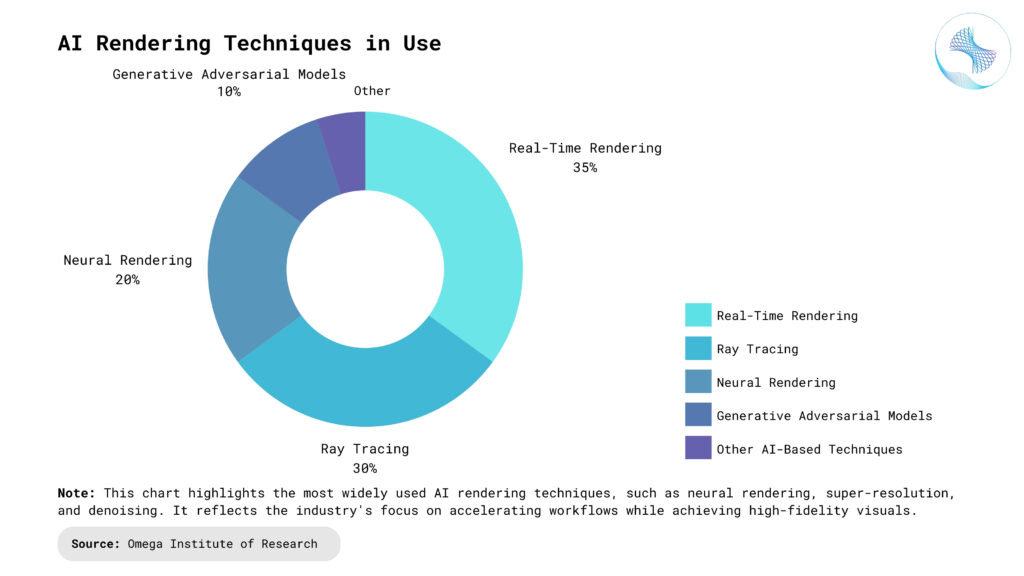- Industries
Industries
- Functions
Functions
- Insights
Insights
- Careers
Careers
- About Us
- Technology
- By Omega Team

In today’s dynamic digital media landscape, where high-quality visuals and rapid production are critical, AI rendering is revolutionizing how visual content is created and experienced. This cutting-edge technology is making waves across industries from crafting lifelike environments in video games to producing stunning visual effects in films and enabling real-time architectural visualization. At its core, AI rendering utilizes advanced machine learning models and neural networks to dramatically accelerate the rendering process while maintaining, or even enhancing, visual fidelity. This not only reduces the need for expensive hardware and lengthy production timelines but also empowers creators to experiment and iterate more freely. As demand for immersive, hyperreal content continues to grow, AI rendering is emerging as a transformative force, reshaping the boundaries of digital artistry and storytelling.

What Is AI Rendering?
AI rendering is the use of machine learning models, particularly deep learning networks to generate or enhance rendered images, often from 3D models. These systems are trained on vast datasets of existing images and learn to understand how visual elements should appear, based on patterns like lighting, texture, color, and geometry. Traditional rendering simulates the physics of light, which is accurate but slow. AI rendering bypasses this by predicting the final look more efficiently. This makes it possible to achieve comparable or even superior results while dramatically reducing processing time and computing cost. It’s transforming workflows across industries by minimizing wait times, enhancing image realism, and enabling real-time previews even on consumer-grade devices. Artists and developers can now iterate more rapidly and focus on creativity rather than technical limitations.

How AI Rendering Works
Denoising: AI denoisers clean up noisy images produced during low-sample path tracing by learning from high-quality ground truths. They detect and reconstruct missing pixels and refine edges, lighting, and textures. This means fewer samples are needed per frame, drastically cutting down render times while maintaining visual fidelity. The AI fills in complex lighting patterns that would otherwise require extensive computation. Denoising tools are now standard in rendering engines like Blender’s Cycles, Arnold, and V-Ray. They enable near-final quality with just a fraction of the processing effort needed by traditional methods.
Super Resolution/Upscaling: AI models like NVIDIA’s DLSS render frames at a lower resolution and upscale them using deep learning algorithms. The neural network adds missing pixels intelligently to create sharp, clear visuals. This improves frame rates, making games smoother without sacrificing image quality. It’s ideal for real-time applications like VR, where performance is critical. Upscaling through AI also enables stunning visuals on less powerful devices, widening access to high-end graphics. It opens the door for richer experiences in gaming and streaming without overloading GPUs.
Predictive Rendering: Instead of calculating every photon interaction or ray trace path, AI learns from previous render outcomes and predicts what a scene should look like. This prediction reduces the number of calculations needed, especially in scenes with complex reflections, refractions, or indirect lighting. It essentially fills in the gaps using learned behavior. As a result, creators get near-instant previews with high realism, enhancing iterative workflows. It is especially valuable in architectural and cinematic design, where time and visual accuracy are both critical.
Style Transfer and Texture Synthesis: AI can generate or replicate artistic styles and textures from reference data, enabling consistent materials across models. It identifies structural patterns and applies them uniformly. For instance, turning a hand-drawn sketch into a textured 3D surface or replicating the look of marble, wood, or skin with photorealistic accuracy. This boosts productivity in game design, animation, and industrial modeling. It also empowers artists to experiment with creative visuals without manually crafting every detail.

Applications Across Industries
Gaming: AI rendering enhances performance and visuals in games using real-time upscaling and noise reduction. Gamers benefit from smoother gameplay with higher graphical fidelity, even on mid-tier GPUs. By reducing hardware strain, developers can create more complex and immersive environments. AI also enables real-time ray tracing features without the typical performance drop. Games become more accessible and visually appealing, and studios save time in development and testing. This leads to faster releases and better player experiences across all platforms.
Film and Animation: Filmmakers use AI rendering to create detailed VFX and 3D animations faster than traditional methods allow. Time-consuming processes like lighting simulation, shadow casting, and texture baking are streamlined. This allows directors and artists to iterate more frequently, experimenting with different looks, effects, and compositions before finalizing scenes. Real-time feedback is now possible in areas that previously took hours. AI reduces rendering costs and helps small studios compete with large production houses. It also supports virtual production environments like LED walls and real-time set extensions.
Architecture and Design: AI rendering tools provide real-time visualization of buildings, interiors, and urban landscapes. Clients and designers can instantly preview changes in materials, lighting, or layout. This speeds up project approvals and reduces costly revisions during later stages. Real-time walkthroughs with photorealistic lighting help communicate ideas effectively. AI also simulates natural light and environmental factors, improving sustainability insights. It transforms how architecture is presented, making designs more interactive and immersive.
Medical Imaging and Scientific Visualization: In healthcare, AI rendering helps convert flat CT/MRI scans into interactive 3D models, aiding in diagnostics and surgical planning. Doctors can explore internal structures from multiple angles in real time, enhancing understanding and precision. AI also helps generate models of biological systems for research and education. In scientific fields, AI accelerates rendering of simulations like climate models, molecular interactions, and fluid dynamics. This speeds up data interpretation and decision-making.
Benefits of AI Rendering
Speed: Traditional rendering can take hours per frame for complex scenes. AI rendering cuts this time drastically by using prediction, upscaling, and intelligent sampling. Scenes that previously took a day to render can now be completed in minutes or seconds, enabling real-time feedback during production. This improves workflow efficiency across industries. Shorter rendering cycles also lead to faster revisions, more iterations, and better final outcomes. Teams can meet tight deadlines without compromising visual quality.
Efficiency: AI rendering needs fewer samples to generate high-quality images. This reduces GPU usage, power consumption, and data storage requirements. Studios can optimize resources, run more renders simultaneously, and reduce their carbon footprint. It also decreases wear and tear on expensive rendering hardware. More efficient rendering pipelines also lower costs for small and mid-size studios. This levels the playing field and fosters innovation by allowing more players to compete in content creation.
Accessibility: AI rendering democratizes high-end visuals by lowering hardware and software barriers. Artists can work on laptops or mid-range PCs and still achieve studio-quality results. Cloud-based AI rendering services further remove infrastructure costs, enabling freelancers and remote teams to participate in advanced projects. This is especially impactful in education, independent filmmaking, and indie game development. More creators can bring their visions to life without steep entry costs.
Creativity: With faster turnaround and real-time feedback, artists can explore multiple creative directions in less time. They’re free to focus on storytelling, emotion, and design. AI assists rather than replaces the artist, acting as a creative partner to enhance workflows. Designers can try bold ideas without worrying about render time. Creative professionals benefit from a more intuitive and responsive process. This encourages experimentation and innovation, pushing artistic boundaries in digital media.

Challenges and Limitations
Data Dependency: AI models rely on high-quality, diverse training datasets to perform well. Poor training data can lead to inaccurate outputs or visual inconsistencies. Biases in the dataset can also affect rendering quality, especially in scenes with unusual lighting, textures, or architecture. This limits generalizability. Developers must carefully curate training data and continuously refine models. This increases complexity and resource requirements during setup and maintenance.
Artifact Risks: AI-generated images can include artifacts such as ghosting, incorrect shading, or blurry textures. These errors often occur in unpredictable scenarios or novel visual contexts.
Unlike traditional renderers that follow strict physics-based rules, AI makes probabilistic guesses, which aren’t always reliable. Errors may go unnoticed until post-production. Artists need to review and correct results manually, adding an extra layer of quality control. In critical projects like medical or architectural visualization, these risks must be carefully managed.Integration Complexity: Adopting AI rendering requires changes to workflows, pipelines, and team skill sets. Traditional tools may not support AI plugins natively. This means studios must invest in training, retooling, and troubleshooting, especially if they rely on legacy systems. Integration with other software like Unreal Engine or Maya can also present compatibility issues. Organizations must weigh these transitional challenges against long-term gains. The learning curve may slow down adoption without strong internal support and leadership.
Predictability: AI models sometimes behave unexpectedly when encountering edge cases or new styles. This unpredictability can make them unreliable in high-stakes applications. For example, a neural network trained on indoor scenes might perform poorly on outdoor environments. It may also introduce visual errors not present in the original model. Teams must build in safeguards, such as manual overrides or hybrid systems that blend AI with traditional methods. This ensures consistent quality across diverse projects.
The Future of AI Rendering
Prompt-Based Rendering: Generative AI tools allow users to describe what they want in plain language and produce matching visuals. This simplifies creation for non-technical users. Tools like Adobe Firefly, Midjourney, and Runway ML are pioneering this space by enabling text-to-image and text-to-video generation. Artists can generate scenes, textures, or models with a few keywords. This bridges the gap between imagination and execution, making visual storytelling more intuitive. Prompt-based rendering may redefine pre-production workflows in film, gaming, and marketing.
Real-Time Cinematic Rendering: AI will enable film-quality visuals in real time using smart upscaling, denoising, and lighting prediction. This is already evident in productions like The Mandalorian. Virtual production techniques combine LED screens, game engines (Unreal Engine), and AI rendering to create dynamic sets that respond to camera movement. This technology shortens post-production timelines and reduces the need for location shoots or green screens. It creates immersive experiences that blend physical and digital storytelling.
3D Object Generation: AI can now generate 3D models from 2D sketches, images, or textual descriptions. Tools like GET3D, Point-E, and Meshy are pushing these boundaries. This reduces reliance on manual modeling, which is labor-intensive and time-consuming. Designers can iterate and prototype rapidly with minimal effort. In the future, AI might allow full virtual environments to be created in minutes from a script or storyboard. This would redefine animation, gaming, AR, and industrial design.
Sustainable Rendering: AI rendering significantly lowers energy consumption by requiring less computation for high-quality results. This supports eco-friendly practices. Studios can run more projects with fewer resources, reducing their environmental footprint. Cloud rendering services powered by renewable energy can further minimize impact. Sustainability is becoming a competitive differentiator in media and entertainment. AI rendering is a step toward greener creative industries without compromising quality.
Conclusion
AI rendering is not just a technical upgrade, it’s a creative revolution. By fusing the intelligence of machine learning with the artistry of digital design, it empowers creators to bring their visions to life faster, more affordably, and with fewer barriers. Whether you’re a game developer, a filmmaker, or an architect, AI rendering is reshaping the boundaries of what’s possible in digital visualization. It reduces reliance on traditional rendering pipelines, streamlines workflows, and opens the door for more iterative, experimental approaches. Moreover, it democratizes high-end production capabilities, allowing smaller studios and independent creators to compete on a global scale. As the technology continues to evolve, we can expect AI rendering to drive innovation not just in how visuals are made, but in how stories are told and experiences are delivered. Ultimately, it marks a pivotal shift toward a future where creativity is no longer constrained by technical limitations.
- https://www.pelicad.com/blog/ai-rendering
- https://www.archdaily.com/1022633/the-future-of-ai-rendering-boost-efficiency-and-cut-costs-with-the-right-tool
- https://www.engineering.com/the-ai-rendering-revolution-this-makes-designers-cry/
- https://www.pelicad.com/blog/ai-renders-architecture
- https://hyscaler.com/insights/ai-rendering/
Subscribe
Select topics and stay current with our latest insights
- Functions